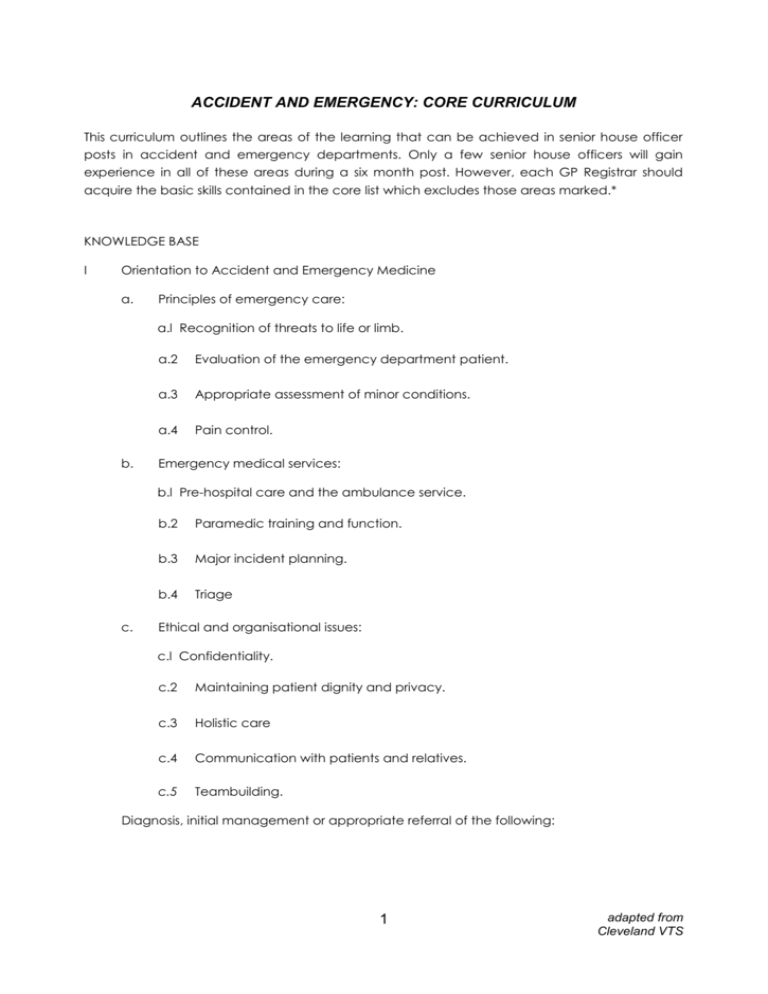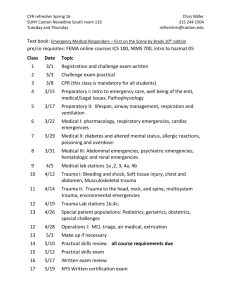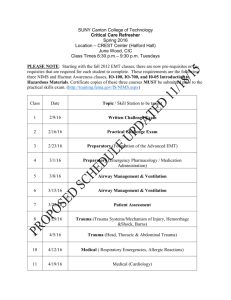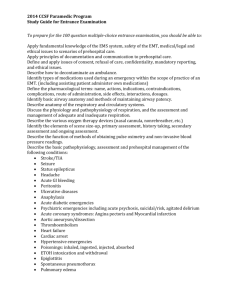a&e core curriculum
advertisement

ACCIDENT AND EMERGENCY: CORE CURRICULUM This curriculum outlines the areas of the learning that can be achieved in senior house officer posts in accident and emergency departments. Only a few senior house officers will gain experience in all of these areas during a six month post. However, each GP Registrar should acquire the basic skills contained in the core list which excludes those areas marked.* KNOWLEDGE BASE I Orientation to Accident and Emergency Medicine a. Principles of emergency care: a.l Recognition of threats to life or limb. b. a.2 Evaluation of the emergency department patient. a.3 Appropriate assessment of minor conditions. a.4 Pain control. Emergency medical services: b.l Pre-hospital care and the ambulance service. c. b.2 Paramedic training and function. b.3 Major incident planning. b.4 Triage Ethical and organisational issues: c.l Confidentiality. c.2 Maintaining patient dignity and privacy. c.3 Holistic care c.4 Communication with patients and relatives. c.5 Teambuilding. Diagnosis, initial management or appropriate referral of the following: 1 adapted from Cleveland VTS II Cardiovascular Diseases a. Cardiopulmonary resuscitation CPR: a.l One-and two-rescuer CPR b. a.2 Conscious and unconscious victim. a.3 Infant CPR Priorities in cardiac arrest - ACLS approach: b.1 Co-ordination and priorities in cardiac arrest. b.2 Drugs and protocols. b.3 Treatment of ventricular fibrillation/ventricular tachyarrhythmias\asytole\electromechanical dissociation\bradyarrhythmias. III c. Chest pain evaluation d. Recognition and treatment of supra-ventricular and ventricular tachycardias: e. Recognition of hypertensive emergencies: Trauma a. Priorities in multiple trauma - ATLS approach: b. Head and facial trauma: c. Spinal trauma including recognition of normal and abnormal C-Spine Xrays: d. Chest trauma: d.l Blunt/penetrating*. e. d.2 Tension pneumothorax. d.3 Pericardial tamponade*. d.4 Massive haemothorax*. d.5 Open chest wound. d.6 Ruptured aorta*. Abdominal trauma: e. 1 Blunt/penetrating. e.2 Indications for diagnostic peritoneal lavage. 2 adapted from Cleveland VTS f. Genitourinary trauma: g. Extremity trauma: g. 1 Skeletal trauma. g.2 h. IV V VI Vascular trauma. Burns: Shock a. Definition and clinical findings: b. Differential diagnosis (septic, hypovolaemic, anaphylactic, cardiogenic, neurogenic): c. Principles of fluid resuscitation: Gastrointestinal Diseases a. Acute GI bleed: b. Dehydration: vomiting, diarrhoea: c. Abdominal pain evaluation: d. Significant foreign body ingestion: Ophthalmological Diseases a. b. Causes of red eye: a. 1 Foreign body/corneal abrasion. a.2 Conjunctivitis. a.3 Acute glaucoma Eye trauma: b. 1 Chemical burns. b.2 Hyphaema. c. Importance of sudden visual impairment: d. Orbital cellulitis: 3 adapted from Cleveland VTS VII VIII IX X Pulmonary Diseases a Acute respiratory failure: b. Acute asthma: c. Pulmonary oedema: d. Pulmonary embolus: e. Choking - foreign body: f Pneumothorax: g. Pneumonia: h. Inhalation injury: I. Evaluation of dyspnoea: j. Carbon monoxide poisoning: Metabolic Emergencies a. Hypoglycaemia: b. Ketoacidosis: c. Electrolyte abnormalities: d. Acid base abnormalities: Genitourinary Diseases a. Urinary tract infection: b. Urinary flow obstruction: c. Nephrolithiasis: d. Venereal disease: e. Pelvic inflammatory disease*: f. Epididymitis: g. Testicular torsion: h. Balanitis: Obstetric/Gynaecological Emergencies a. Ectopic pregnancy: b. Pregnancy with first or third trimester bleed: 4 adapted from Cleveland VTS c. XI XII XIII XIV Sexual assault: Toxicological Emergencies a. Initial recognition, treatment and removal of poisons: b. Role of poison centres: C. Management of common poisons (paracetamol, aspirin, narcotics etc): d. Specific therapy: Childhood Emergencies a. Child abuse: b. Croup\epiglottitis: c. Fever evaluation in an infant: d. Serious dehydration: e. Meningitis: f. Seizures: Environmental Emergencies a. Heat illness: b. Hypothermia: c. Near drowning: d. Electrical injury: e. Bites: f. Anaphylaxis: ENT Diseases a. Epistaxis/septal haematoma: b. Foreign bodies: C. d. Infections: Upper airway obstruction and the theory of cricothyroidotomy: e. Dental emergencies: Maxillo-facial emergencies: 5 adapted from Cleveland VTS XV XVI XVII Neurological Diseases a. Coma: b. Headache: C. Meningitis: d. Seizures: e. Cerebro-vascular accident: f. Altered mental status: Musculo-skeletal a. Orthopaedic and neurovascular extremity examination: b. Recognition and management of: b. 1 Specific aspects of hand injury. b.2 Strains/sprains. b.3 Septic/irritable joint. b.4 Fractures and dislocations. b.5 Soft tissue injury/infection. Behavioural Emergencies a. Recognition of behavioural disorders caused by organic illness: b. Suicidal and homicidal evaluation: C. Recognition of acute psychosis: d. Performance of mental status examination*: e. Drug and alcohol abuse: SKILLS I Wound Repair a. Suture material, needles, instruments: b. Types of wound: c. Wound preparation: d. Tetanus prophylaxis: e. Local anaesthetic techniques: f. Dressing techniques: 6 adapted from Cleveland VTS II Cardiopulmonary Resuscitation (from ACLS) III Initial Trauma Management (from ATLS) IV Defibrillation and Cardioversion a. Defibrillator operation: b. Indications: V Vascular Access VI Airway Control a. Face ventilation (eg Laerdel): b. Intubation: VII Splinting/lmmobilisation VIII Cervical Spine Immobilisation IX Gastric Lavage* X Log Rolling* XI Superfical ~ XII Nasal packing* XIII Needle Thoracostomy* XIV Thoracostomy The Drainage* XV Reduction of Fractures and Dislocations* XVI Preparation of Medico-legal Statements to the Police/Police Coroner* 7 adapted from Cleveland VTS








